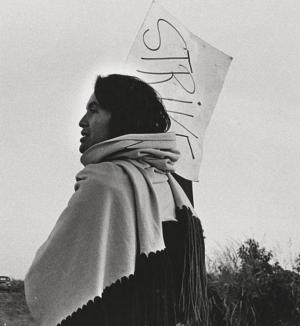Introduction to Activism

This lesson takes a closer look at one of key activists in the women’s’, workers’ and immigrants’ rights movement in the 20th century.
45-minutes
By lesson’s end students will compare how Dolores Huerta and Cesar Chavez impacted the farm workers’ rights in California.
Knowledge of Cesar Chavez
- Powerpoint with photographs (teacher created)
- Access to internet to play Sacramento speech clip
- Copies of excerpts of Sacramento speech
- Paper so students can answer excerpt questions
- Lesson Plan PDF
- Display the following photograph on the board and ask students to participate in a turn-and-talk. Discuss with their elbow partners what they see in the photograph and what could it be referring to (link to photograph).
- Complete a whip-around to ensure that all pairs have shared what they have seen in the photograph and what the women are representing/doing.
-
Introduce Dolores Huerta. Consider creating a brief power point to share with students. (extra resources from the Dolores Huerta Foundation)
-
Was born on April 10th, 1930 in Dawson, New Mexico
-
Her father was a farm worker, miner, and union activist. Her mother was active in their community, welcoming low-wage workers to rent rooms at her hotel.
-
Dolores became an organizer under the Stockton Community Service Organization. She founded the Agricultural Workers Association soon afterwards. During her time with Stockton CSO, she met Cesar Chavez and they launched the National Farm Workers Association together.
-
“Huerta was able to secure ‘Aid for Dependent Families’ and disability insurance for farm workers in California in 1963. She was also active in the enactment of the Agricultural Labor Relations Act of 1975. The ALR Act allowed farm workers in California the right to organize and collectively bargain for better wages and working conditions.”
-
Huerta is also instrumental in the feminist movement after encountering Gloria Steinem in New York while she was directing the first national boycott of California Table Grapes. Huerta then began to test gender inequality within the farm workers’ movement.
-
In 2012, President Obama awarded Dolores Huerta with the Presidential Medal of Freedom, the highest civilian award in the United States. Huerta’s response (taken from her website): “The freedom of association means that people can come together in organization to fight for solutions to the problems they confront in their communities. The great social justice changes in our country have happened when people came together, organized, and took direct action. It is this right that sustains and nurtures our democracy today. The civil rights movement, the labor movement, the women’s movement, and the equality movement for our LGBT brothers and sisters are all manifestations of these rights. I thank President Obama for raising the importance of organizing to the highest level of merit and honor.”
-
-
Next, show students a clip and read some excerpts of Dolores Huerta speaking in Sacramento after a march with the National Farm Workers Association, threatening to strike if the Governor of California does not allow the farm workers to collectively bargain for higher wages and better working conditions.
-
Questions for students to answer while reading the excerpts:
-
Why did the farm workers march to Sacramento?
-
Why is important that the National Farm Workers Association be funded by the farm workers?
-
What specifically does Huerta want Edmund Brown (California Governor) to do?
-
How will the National Farm Workers Association respond if Governor Brown does not meet their demands?
-
-
Students should work in pairs to answer the questions. Tell them to underline or highlight in the text where they found their answers.
-
Once students have finished answering the questions, collect their sheets and debrief the excerpt questions. Make sure students are stating where they found their answer in the text.
-
Full Class Discussion:
-
Did the Sacramento march work? Were the farm workers able to collective bargain for better wages and working conditions? (yes, but not until 1975 – from lecture)
-
In a brief construction response, explain whether Huerta or Chavez had the most impact on the farm workers’ rights movement in California and why. Use evidence from our primary sources to support your claim.
Lesson Extension: Ask students to write a blog post about Huerta’s legacy of activism and include a minimum of one picture.
CCSS.ELA-LITERACY.RH.9-10.1
Cite specific textual evidence to support analysis of primary and secondary sources, attending to such features as the date and origin of the information.
CCSS.ELA-LITERACY.RH.9-10.9
Compare and contrast treatments of the same topic in several primary and secondary sources.
D3.3.9-12. Identify evidence that draws information directly and substantively from multiple sources to detect inconsistencies in evidence in order to revise or strengthen claims.
